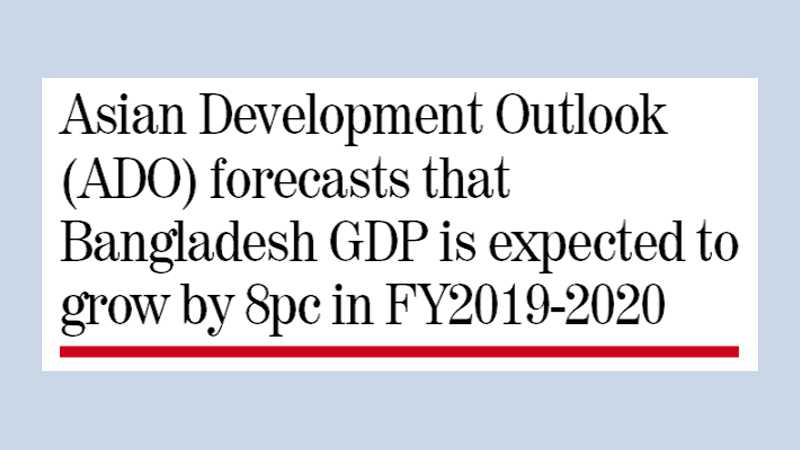Bangladesh likely to see fastest economic growth in Asia: ADB

Bangladesh's economy is likely to see the fastest growth in Asia and the Pacific, a new Asian Development Bank (ADB) report said Wednesday.
The Asian Development Outlook (ADO) 2019 forecasts that Bangladesh GDP is expected to grow by 8% in FY2019-2020 with robust private consumption, increased public investment, strong export performance, and expansion in industries.
“Bangladesh economy is in a good shape and is likely to continue to grow at 8 per cent in FY19 and FY20,” said ADB Country Director Manmohan Parkash while launching the Asian Development Outlook (ADO) 2019 at its office in the capital.
ADB senior economist Soon Chan Hong made a power-point presentation on the ADO’s Bangladesh country chapter. According to the latest provisional figures of the Bangladesh Bureau of Statistics (BBS), the GDP growth rate in the country is going to reach 8.13 per cent in the current fiscal year.
The ADB Country Director said on the whole 8 per cent growth rate is a good growth rate that everybody can be proud of. “But, at the same time you have a lot of challenges to sustain it.”
Mentioning that the economy of Bangladesh has had a very good year like good crop outlook, good exports and remittances, he said, “If you continue to build good infrastructures…….then 8 percent growth can be moved to even 10 per cent for sure in the future.”
Parkash said Bangladesh is already a role model and probably can be a bigger role model.
Asked whether it is possible to go beyond this 8 per cent growth rate, he said, “In a holistic point of view, 8 per cent is a very good growth rate and we would like to congratulate the government. We now suggest that you should build on this 8 per cent and look at the things that can be done to gain 8 per cent or higher than 8 per cent,”
The ADB Country Director said for getting beyond 8 per cent growth, there is a need for skills development, infrastructures development, investing on to the newer technology, investing on diversifying on export baskets, consolidating this healthy growth momentum for the next 3 to 5 years, creating a good macroeconomic policy environment, sound debt management, much easier cost of doing business, a good governance framework, investment in human capital and inclusive development.
He said that Bangladesh’s GDP growth rate rose to 7.9 per cent in FY18 up from 7.3 per cent in FY17, recording the highest GDP growth since 1974.
Parkash said the country’s macroeconomic management remains generally sound as inflation edged up slightly to 5.8 per cent, but remained in check.
“Although budget revenue underperformed its target, the fiscal deficit was well within the budget target………..export performance is expected to excel, and net exports are likely to add to growth. On the supply side, further expansion in industry is expected to be the main driver of growth in FY19,”
The latest Asian Development Outlook (ADO) 2019 said favorable trade prospects are expected to continue despite a weaker global growth. Exports and remittances are likely to be further strengthened while strong public investment is envisaged due to continued policy environment and expeditious implementation of large infrastructure projects.
“To sustain this momentum in the medium- to long-term, Bangladesh requires expanded industrial base, diversified export basket, improved business environment for vibrant private sector development, expanded tax base, better revenue collection for increased resource allocation, and human capital development,” said the ADB Country Director.
“Continued focus on prudent macroeconomic policies, sound debt management, strengthening the banking sector, removing infrastructure constraints, and reducing the cost of doing business are important to help achieve the long-term development vision of the country,” he added.
In his presentation, Soon Chan Hong said strengthening the banking sector is essential for sustaining higher investment and growth.
He also underscored the need for addressing some challenges in the banking sector that include high Non Performing Loan (NPL) ratio, low profitability, weak governance, widening capital shortfall, operational inefficiency and ineffective legal framework.
Source: http://www.theindependentbd.com
Tags :
Previous Story
- Bangladesh exports to US grew 6.42% in 2018
- Trade war a boon for Bangladesh: ADB
- Bangladesh shouldn’t rely too much on overseas borrowing:...
- $45.4 mn to spur solar-driven pumping for irrigation...
- ASIA AND THE WHOLE WORLD FACED WITH A...
- ADB expects 7pc GDP growth
- ADB hopes over 7% GDP growth in BD...
- ADB study pinpoints high costs of doing business...